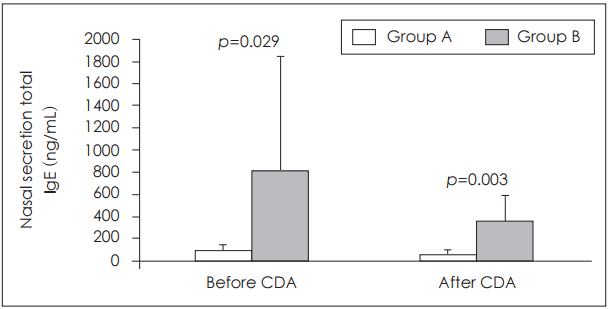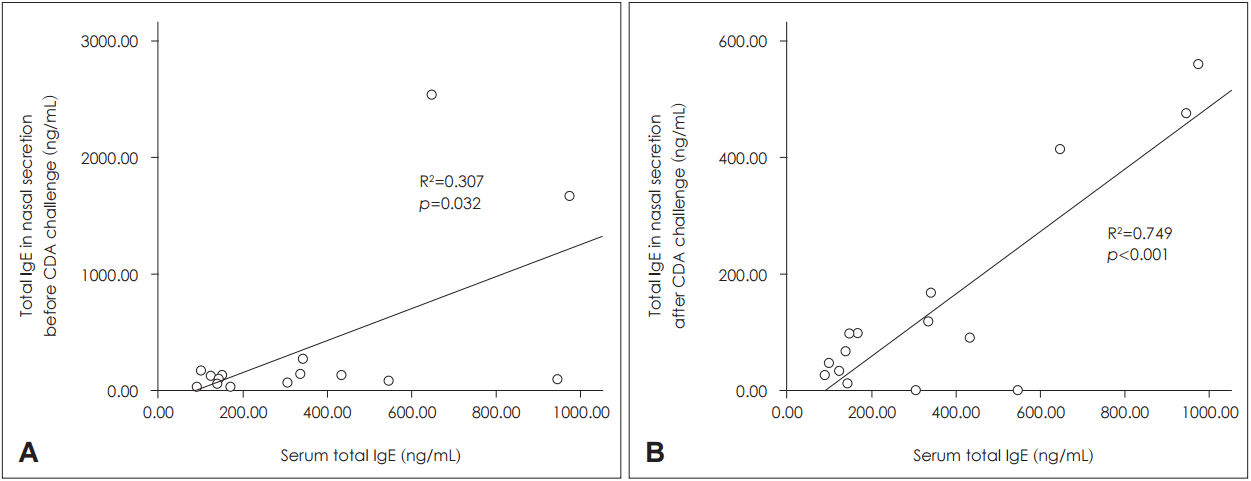1. Jacobs R, Lieberman P, Kent E, Silvey M, Locantore N, Philpot EE. Weather/temperature-sensitive vasomotor rhinitis may be refractory to intranasal corticosteroid treatment. Allergy Asthma Proc. 2009; 30(2):120–7.

2. Lluch-Bernal M, Dordal MT, Antón E, Campo P, Colás C, Dávila I, et al. Nasal hyperreactivity: nonspecific nasal provocation tests. Review by the rhinoconjunctivitis committee of the spanish society of allergy and clinical immunology. J Investig Allergol Clin Immunol. 2015; 25(6):396–407.
3. Braat JP, Mulder PG, Fokkens WJ, van Wijk RG, Rijntjes E. Intranasal cold dry air is superior to histamine challenge in determining the presence and degree of nasal hyperreactivity in nonallergic noninfectious perennial rhinitis. Am J Respir Crit Care Med. 1998; 157(6 Pt 1):1748–55.

4. Kim YH, Oh YS, Kim KJ, Jang TY. Use of cold dry air provocation with acoustic rhinometry in detecting nonspecific nasal hyperreactivity. Am J Rhinol Allergy. 2010; 24(4):260–2.

5. Kim YH, Jang TY. Diagnostic criteria of nonspecific hyperreactivity using cold dry air provocation with acoustic rhinometry. Otolaryngol Head Neck Surg. 2011; 144(1):91–5.

6. Kim YH, Jang TY. Usefulness of the subjective cold hyperresponsiveness scale as evaluated by cold dry air provocation. Am J Rhinol Allergy. 2012; 26(1):45–8.

7. Kim YH, Jang TY. Nasal provocation test using allergen extract versus cold dry air provocation test: which and when? Am J Rhinol Allergy. 2013; 27(2):113–7.

8. Shusterman DJ, Tilles SA. Nasal physiological reactivity of subjects with nonallergic rhinitis to cold air provocation: a pilot comparison of subgroups. Am J Rhinol Allergy. 2009; 23(5):475–9.

9. Van Gerven L, Boeckxstaens G, Jorissen M, Fokkens W, Hellings PW. Short-time cold dry air exposure: a useful diagnostic tool for nasal hyperresponsiveness. Laryngoscope. 2012; 122(12):2615–20.

10. Togias AG, Naclerio RM, Proud D, Fish JE, Adkinson NF Jr, Kagey-Sobotka A, et al. Nasal challenge with cold, dry air results in release of inflammatory mediators. Possible mast cell involvement. J Clin Invest. 1985; 76(4):1375–81.

11. Proud D, Bailey GS, Naclerio RM, Reynolds CJ, Cruz AA, Eggleston PA, et al. Tryptase and histamine as markers to evaluate mast cell activation during the responses to nasal challenge with allergen, cold, dry air, and hyperosmolar solutions. J Allergy Clin Immunol. 1992; 89(6):1098–110.

12. Philip G, Jankowski R, Baroody FM, Naclerio RM, Togias AG. Reflex activation of nasal secretion by unilateral inhalation of cold dry air. Am Rev Respir Dis. 1993; 148(6 Pt 1):1616–22.

13. Kim YH, Jang TY. Subjective cold hyper-responsiveness grade reflects age- and duration-related increase of nonspecific nasal hyperreactivity. Auris Nasus Larynx. 2013; 40(2):184–8.

14. Wang DY, Clement P. Pathogenic mechanisms underlying the clinical symptoms of allergic rhinitis. Am J Rhinol. 2000; 14(5):325–33.

15. Yamazaki M, Kimura K, Watanabe S, Komiyama O, Mishiku Y, Yamamoto K, et al. [Use of a rapid detection assay for influenza virus, on nasal aspirate specimens]. Kansenshogaku Zasshi. 1999; 73(10):1064–8.

16. Besançon-Watelet C, Béné MC, Montagne P, Faure GC, Jankowski R. Eosinophilia and cell activation mediators in nasal secretions. Laryngoscope. 2002; 112(1):43–6.
17. Niehaus MD, Gwaltney JM Jr, Hendley JO, Newman MJ, Heymann PW, Rakes GP, et al. Lactoferrin and eosinophilic cationic protein in nasal secretions of patients with experimental rhinovirus colds, natural colds, and presumed acute community-acquired bacterial sinusitis. J Clin Microbiol. 2000; 38(8):3100–2.

18. Kim SS, Kim KS, Lee JG, Park IY, Koo JS, Yoon JH, et al. Levels of intracellular protein and messenger RNA of mucin and lysozyme in normal human nasal and polyp epithelium. Laryngoscope. 2000; 110(2 Pt 1):276–80.

19. Ingels K, Durdurez JP, Cuvelier C, van Cauwenberge P. Nasal biopsy is superior to nasal smear for finding eosinophils in nonallergic rhinitis. Allergy. 1997; 52(3):338–41.

20. Gevaert P, Lang-Loidolt D, Lackner A, Stammberger H, Staudinger H, Van Zele T, et al. Nasal IL-5 levels determine the response to anti-IL-5 treatment in patients with nasal polyps. J Allergy Clin Immunol. 2006; 118(5):1133–41.

21. Klimek L, Reske-Kunz AB, Malling HJ. [Methods for monitoring of therapeutic efficacy in immunotherapy of allergic rhinitis]. Wien Med Wochenschr. 1999; 149(14-15):394–402.
22. Kim YH, Jang TY, Kim JE, Lim DW, Kim KS. Comparison of collecting methods of nasal fluids using albumin after nasal provocation in allergic patients. Korean J Otorhinolaryngol-Head Neck Surg. 2010; 53(10):615–9.

23. Kim JK, Sung YW, Jang HJ, Lim CH, Shim DB, Shin HA. The effect of allergen provocation on the nasal cycle. Korean J Otorhinolaryngol-Head Neck Surg. 2004; 47(12):1261–66.
24. Shin SY, Cho JS, Jin YW, Lee KH, Moon JH, Cha CI. Result of allergic skin test, MAST and nasal provocation test in children with atopic dermatitis. Korean J Otorhinolaryngol-Head Neck Surg. 2001; 44(5):499–505.






 PDF
PDF Citation
Citation Print
Print



 XML Download
XML Download